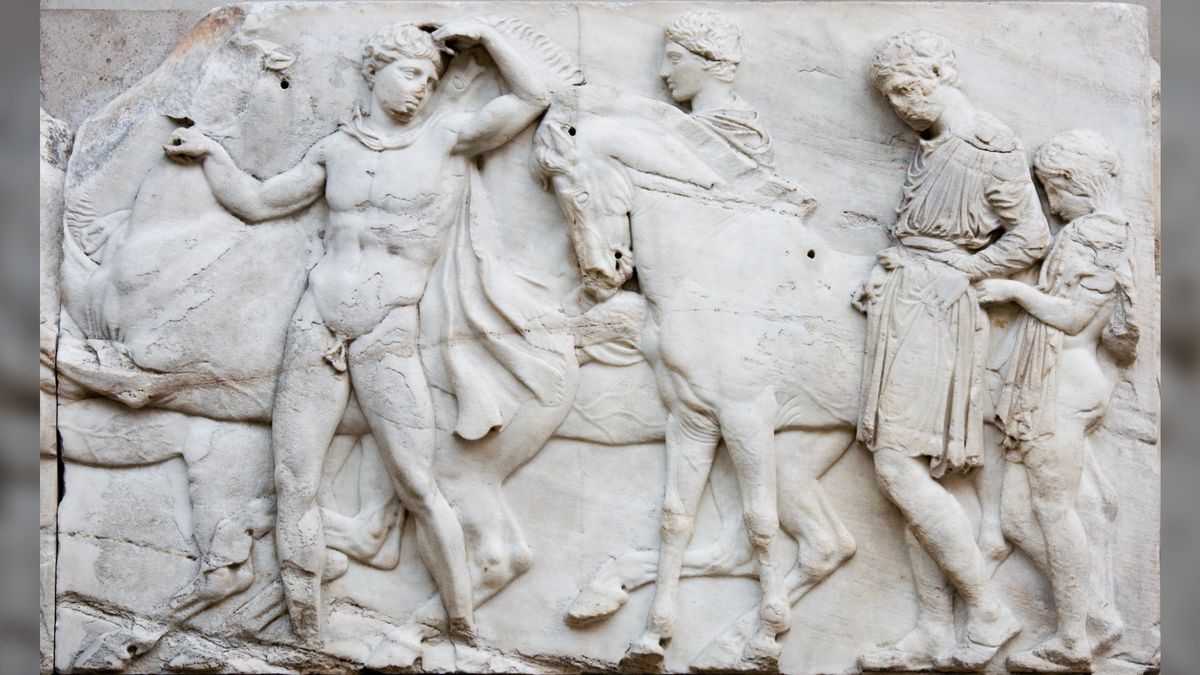Anthropology
Related: About this forumTraces of Colorful Paint Detected on Parthenon Sculptures
Friday, October 13, 2023
Greece Parthenon Paint Traces(Giovanni Verri, ©Trustees of the British Museum)CHICAGO, ILLINOIS—Live Science reports that a new examination of the Parthenon Sculptures housed in the British Museum using luminescence imaging has revealed traces of ancient paint. Giovanni Verri of the Art Institute of Chicago and his colleagues mapped the elements on the carvings, and detected floral designs and smudged figures. The team identified several types of pigment on the sculptures: Egyptian blue, purple made with an unknown recipe, and two types of white, one made with gypsum and the other with bone ash. Evidence of paint on the backs of the sculptures suggests they were decorated before being installed in the Parthenon, the temple built on the Athenian Acropolis in the fifth century B.C. and dedicated to the Greek goddess Athena. “The elegant and elaborate garments were possibly intended to represent the power and might of the Olympian gods, as well as the wealth and reach of Athens and the Athenians, who commissioned the temple,” Verri said. The Parthenon was damaged by warfare in the seventeenth century, and then, in the early nineteenth century, about half of the surviving sculptures were removed by Thomas Bruce, the seventh Earl of Elgin and Britain’s ambassador to the Ottoman Empire, which ruled Greece at the time. Elgin went on to sell the collection to the British government. To read in-depth about efforts to restore the Parthenon and its neighboring structures, go to "The Acropolis of Athens."
https://www.archaeology.org/news/11835-231013-parthenon-sculptures-paint
~ ~ ~
Hidden colors and intricate patterns discovered on the 2,500-year-old Parthenon Marbles from ancient Greece
By Ben Turner published 4 days ago
The ancient Greek statues were assumed to be spotlessly white, but a new study reveals that the Parthenon Sculptures once burst with color.

The Elgin Marbles stolen from Greece. From left to right we see a horse, a naked Greek man leading the way, whilst looking back at the others. Then there's another horse. Next to the horse is a person, and behind the horse if a person clothed in a tunic and a child with cloth draped around their shoulders.
This section from the Parthenon Marbles is now white, but it was painted when it was first crafted in the fifth century B.C. (Image credit: markrhiggins via Getty Images)
The Parthenon Sculptures, also called the Elgin Marbles, were crafted by ancient Greeks 2,500 years ago to decorate the outside of the Parthenon temple in Athens. Now housed at the British Museum in London, they, like many old sculptures, are a muted mix of white, gray and beige.
But a new study reveals that the famous sculptures' hues weren't always so drab — in fact, they were once painted with vibrantly colored and intricate patterns.
Bright Egyptian blues, whites and purples once covered the statues depicting deities and mythical creatures guarding the fifth-century-B.C. temple. The colors were used to represent the water that some figures rose from, the snakeskin of a mysterious sea serpent, the empty space and air in the background behind the statues, and figurative patterns on the robes of the gods, the researchers wrote in the study, which was published Wednesday (Oct. 11) in the journal Antiquity.
More:
https://www.livescience.com/archaeology/hidden-colors-and-intricate-patterns-discovered-on-the-2500-year-old-parthenon-marbles-from-ancient-greece